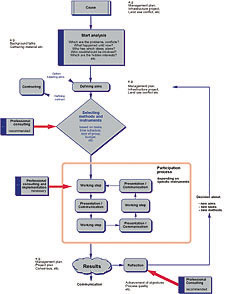Participation has always been an important element of human interaction if not the basic principle of human existence. The origin of today’s debate about participation and civil society can be traced back to the environmental movements in Western Europe and the U.S. in the 1970s and the organisation of civil groups in Eastern Europe in the 1980s. Some elements of the participation process such as mediation procedures were first developed in the United States and later adopted in Europe.
Encouraging the public to participate
The growing awareness about the importance of public participation over the past few years has found its expression in much of the EU legislation and programmes. The 5th and 6th EU Framework Research Programmes, for example, encourage co-operation between inter- and transdisciplinary teams; the EU LEADER+ Initiative aims to involve local people in innovative regional planning. Natura 2000 Process, the Strategic Environmental Assessment and the Environmental Noise Directive, the Aarhus Convention and Local Agenda 21 – all these directives and processes call for active participation of the public. Although public participation per se is a "bottom up" process, its promotion seems to be a "top down" process given that the demands to boost public involvement in decision making processes now obviously come from the highest levels of administration. At the same time that the public is encouraged to participate, it has become increasingly sceptical of large and complex projects and plans. Individual citizens and local initiative groups demand that they be informed and that they be given a say in decision-making processes. In many European countries this has led to a new culture of co-operation in the public sector. The approach behind the EU Water Framework Directive regarding public participation fits very well into this trend.
Eight elements of the culture of participation
Getting the public to participate requires some change of attitude on the part of individual and group stakeholders. This applies to all three stages in the public participation process, i.e.:
(1) distribution/acquisition of information (e.g. mail, posters, presentations);
(2) consultation (e.g. inquiry, interview, hearing, petition);
(3) active involvement in decision making (e.g. round table, future conference, mediation procedure).
Practical experiences from various participation and mediation projects have enabled eight elements of a culture of participation to be deducted from an example - a case in which a management plan was created in a participatory approach. The eight elements include:
1. Team work
Public participation requires group work. Facilitators who assist bigger
groups to work out a management plan, for example, should work at least
in pairs. This helps to handle critical situations and to reflect on the
process.
2. Roles
Public participation requires clear roles. Who can take part? Who takes
over what mandate? What are the participants' rights and duties? Who will
implement the management plan? Who will do the monitoring? Mixing the roles
causes confusion and might lead to additional conflicts.
3. Appreciation
Each individual is valuable for the process. Lay persons should be viewed
as experts highly qualified on matters concerning their local environment.
Especially in heterogeneous groups composed of e.g. farmers, tourist experts,
water suppliers, energy specialists, administrative bodies etc, the recognition
of the other participants and of other interests is a pre-condition for
good co-operation.
4. Preparation
Public participation calls for detailed preparation. A well-designed process
can help to avoid problems later on. Ignoring the key players or the existing
conflicts or embarking on the process with unrealistic expectations can
lead to a "participation disaster”. Before each step of the elaboration
of a management plan, there should be time to assess the actual situation
and think about different possibilities. Facilitators should always have
a ´strategic reserve´ for critical situations.
5. Agreements
The structure and the rules of the process as well as the expected outcomes
have to be clearly defined from the beginning onwards: how much influence
do the participants have on the contents of the management plan? How will
decisions be made? By whom, how and by when will the plan be implemented?
Who will do the monitoring? If these questions remain unclear, the participants
will accept neither the procedure nor the results of the management plan
and some might even step out of the ongoing process.
6. Questions
Asking questions is much better than "telling the (own) truth´.
It helps to understand other positions, brings different interests forward
and widens the room for negotiation. It is the duty of the facilitators
to ask the right questions and to enable the parties to do the same.
7. Documentation
A complete and clear documentation of the process and of all interim results
helps to avoid potential misunderstandings and serves as the basis for trustful
co-operation.
8. Reflection
Public participation is a permanent learning process. Self-reflection, monitoring
and evaluation are a pre-condition for quality assurance.
Implementing those eight principles does not guarantee immediate success,
but – as several examples in the field of urban, regional and environmental
planning have shown – it does help to make participation work.
